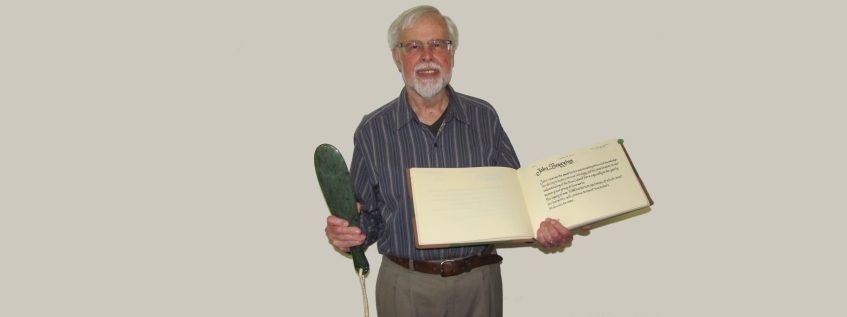Allan Mere Award for 2013:
Dr John Braggins

John Braggins, recipient of the Allan Mere Award for 2013. Photo: © Joshua Salter.
The NZBS Committee is pleased to announce that the 2013 award of the Allan Mere is to John Braggins, retired Senior Lecturer, University of Auckland (1970s–90s), and Honorary Research Associate of the Auckland War Memorial Museum. John receives the award for his outstanding botanical knowledge, his ability to inspire interest bryology, and his contribution to the New Zealand flora, especially in the poorly known plant group of liverworts.
Peter de Lange and Brian Murray nominated John and the proposal was supported by the Auckland, Nelson and Wellington Botanical Societies, New Zealand Conservation Plant network, and a range of John’s research associates, colleagues, former students and friends: Jessica Beever, Dan Blanchon, Paul Cashmore, Alison Downing, John Engel, David Galloway, Rhys Gardner, Matt Renner, Joshua Salter, Rodney Seppelt, Nicholas Singers, and Matt von Konrat. A selection of comments below from the proposers and supporters indicates the breath and special areas that John’s botanical contributions cover.
His widely unrecognised and underappreciated success has been in teaching, mentoring and then releasing en masse into the botanical community a new wave of highly skilled, professional biosystematists.
His work has been the silent motivator behind so many botanical success stories both in New Zealand and overseas. John is still the first port of call in New Zealand for all things hepatic by the world’s experts. He has worked closely with all the key people in the world, and won their admiration – perhaps seen best by the naming of a new, monotypic genus of liverwort after John, the ever aptly named Bragginsella anomala!
John’s intimate knowledge of New Zealand plants, including a broad spectrum of angiosperm and cryptogam groups, never ceases to amaze me. This attribute, together with a curious mind, and an exacting nature, sets John apart from most botanists. All of these attributes served John well in his role as teacher, a lecturer, and a mentor for several PhD students, each of whom tackled complicated genera of liverworts (Elizabeth Brown, Matt Renner, Matt von Konrat), a MSc and PhD student researching a complicated genus of lichens and irises (Dan Blanchon), and a PhD student working with ferns (Mark Large) publishing jointly in 1991 a Spore Atlas of New Zealand ferns & fern allies (followed later by a joint publication on tree ferns of the world).
His field trips were legendary, passing on his huge enthusiasm for his branch of botany and inspiring several young botanists to follow in his footsteps.
Our ability to understand the intricacies of the Australian hepatic flora would be much poorer without John’s considerable help and encouragement over many years.
The strength and uniqueness in his influence lies in its breadth, in such a way that few other botanists in New Zealand have probably been able to achieve. This includes: reaching students over many generations, a scholar, international capacity building, collections beyond New Zealand, his broad botanical knowledge and broad research interests, his photography, and as one of the leading advocates for bryophytes in New Zealand.
John has very high standing in the international bryological community and has been outstanding ambassador for New Zealand hosting scores of international scientists.
I have had memorable days in the field with him, he has helped me innumerable ways in my own studies…, sharing his wide experience and his beautifully taken images. His generosity is legendary. John has contributed to New Zealand botany over the many years and in many different ways, as a teacher, guide, mentor, enthusiastic collaborator, overlooked dogsbody, and a dogged researcher, never looking for self-advancement or any particular glory. His contributions on a wide front are noteworthy.
Part of his legacy will be the vast holdings in herbaria of the specimens he has collected and/or annotated. To date the AK herbarium (at Auckland Museum, now also incorporating AKU the Auckland University herbarium), where the bulk of his collections are housed, contains 14,959 [72% are liverworts] accessioned plant specimens collected by him (including joint collections) and 13,619 identified by him.
I feel well qualified to judge John’s contribution to New Zealand botany. It has been, and continues to be, outstanding.
Importantly, the impact John has had will last for many generations in different facets, which is the hallmark of an influential biologist.
John’s significant contribution to the furtherance of the study of hepatics in Australasia, and the broader understanding of the new Zealand hepatic flora, has been highlighted recently in a special tribute to his achievements by Rod Seppelt and others: ‘Excellent, now I can concentrate on the liverworts’ – A testimony to the work of John Braggins. Australasian Bryological Newsletter 61: 2–8, 2012.
John is the 15th recipient of the Mere since the NZBS was asked to administer the award in 1999 with the disestablishment of Botany Division DSIR who used to present the Mere to deserving staff members (see Newsletter 57).
Anthony Wright presented the Allan Mere to John at the monthly Auckland Botanical Society meeting at UNITEC on 2nd October, 2013.
Ewen Cameron, Secretary, New Zealand Botanical Society
Citation reproduced from the New Zealand Botanical Society
Newsletter, No.
113, Sept 2013.